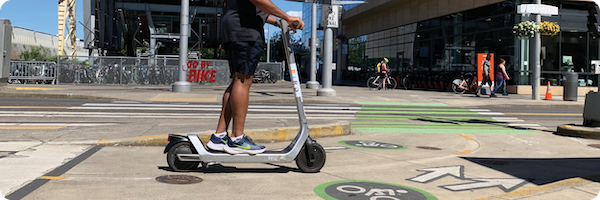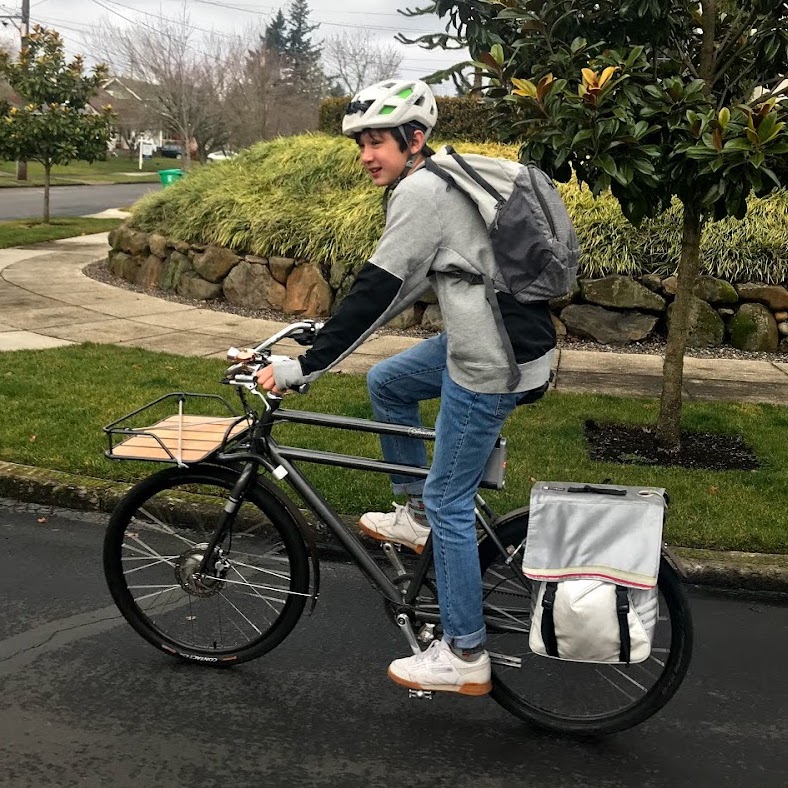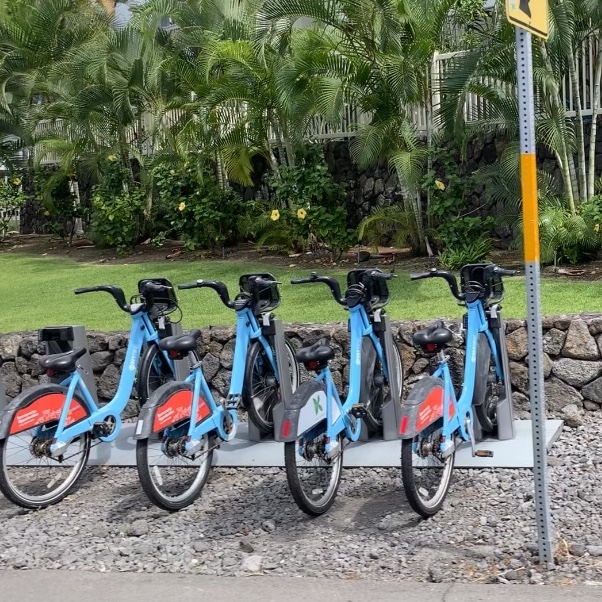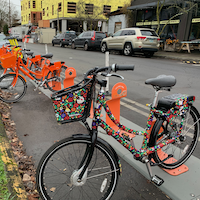New Mobility and Technology

Over the past 20 years, advances in technology have offered new opportunities for the mobility of people and goods. Transportation professionals have much to learn about the potential impacts of these emerging technologies on the creation of sustainable, livable, and equitable communities. Download the full literature review of NITC research in new mobility and technology here, or you can download our two-page summary here.
In a series of NITC Research Roadmaps, we surveyed a decade of contributions across six areas of transportation research funded by the National Institute for Transportation and Communities (NITC).
New Mobility: Impacts on Equitable Mobility
Advances in computer, cellular, and remote sensing technologies are expanding opportunities for the mobility of people and goods. The widespread adoption of smartphones has increased mobility options, as has the development of “new mobility” shared platforms including e-scooters, bikeshare, transportation network companies (TNCs), carshare, and microtransit. Given the relative nascency of these technologies, academics and the public and private sectors still have much to learn about the opportunities and challenges involved in their widespread adoption. But who is being left behind as technology advances?
Most of NITC's work around shared mobility programs focuses on equity, exploring how to increase participation and reduce barriers. A study on TNCs found that ride-hailing fills a transportation gap for nonprofits that provide services to communities, and recommends subsidies to support their use. A third study evaluated a program from the City of Portland in Oregon which provided transportation credits for residents of affordable housing, and found that many of the program's participants tried new modes they hadn't used before. They explored how e-scooters can be used in conjunction with other modes, such as bikeshare membership and transit, to improve access for residents on a low-income through the “Transportation Wallet” program. Other research examined the equity requirements of over 230 shared mobility programs and bike share programs across the U.S. and evaluated how effective these programs are at increasing adoption among target populations.
New Mobility: Impacts on Health and Safety
Safety is a major concern when examining e-scooter adoption in cities. NITC researchers have examined the safety of e-scooters and of interactions with other modes, as well as user demographic and location considerations. One study considers the impact of e-scooters on activity levels and the prevalence of chronic disease. NITC funds have also been used to study e-scooter parking and the safety issues related to e-scooters that potentially block sidewalks and curb cuts.
New Mobility: Implications for Public Policy
There is a body of research funded by NITC that explores models of governance and policy approaches for the deployment of new mobility pilot projects, including micromobility and autonomous vehicles (AVs). In addition to providing model language for regulations, NITC researchers are considering the fiscal implications of some of these services. One study examined how the adoption of AVs is changing both mobility and e-commerce deliveries, and how cities can adopt a new mobility strategy in response to these changes. Another explored the potential fiscal impacts of AVs on cities through the proxy study of TNCs, and suggested regulatory changes to mitigate these impacts. A third assessed over 220 new mobility and urban delivery pilot projects in the US and Canada, and conducted 11 case studies to catalog lessons learned, emerging trends and considerations and promising practices.
A forthcoming review of e-scooter adoption in Portland, OR will examine the change in vehicle miles traveled (VMT) since adoption. Researchers will analyze the charging operations of e-scooter companies in the metro region and the mode shift of individuals using e-scooters. Results from this study aim to estimate the impacts of different company operations and best practices in increasing safety, addressing equity, and reducing air pollution.
Transportation Technology: Implications for Transportation System Management
New technologies are improving the design and operations of intelligent transportation systems (ITS) through improved signals, sensors, travel time predictions, and connected vehicles (CVs). Some NITC work has involved the creation or improvement of ITS technology, while others have explored the implications of its use.
Researchers are exploring highway performance with connected autonomous vehicles (CAVs) and their interaction with human-driven vehicles. One study used data-driven optimization models and efficient computation methods to help solve e-scooter distribution and operation problems. Another examined how AVs will affect VMT within cities and developed an open-source software tool which simulates different scenarios of AV adoption, to identify policy responses that would ensure sustainable and equitable travel and land use.
Other NITC work focuses on the changing travel behaviors associated with online shopping, such as examining how the COVID-19 pandemic has changed shopping habits among American consumers. Other studies examine the environmental impacts of e-commerce, including travel-related emissions and the recycling of shipping packaging and materials, which may strain recycling systems and waste collection.
Transportation Technology: Prioritizing Active Transportation
Smart city research focuses on making the transportation system more efficient and increasing traffic flow and safety. Research encompasses multiple modes, including transit, bikes, and automobiles. One study focused on improving flow for bicyclists on a bike corridor with fixed-time signals using a cellphone-based app. Another study, in progress, is finding more ways to incorporate pedestrians and bicyclists into CV applications, and a third study explored various applications of connected bicycles and found that they may reduce barriers to bicycle mode share and better accommodate cyclists.
NITC-supported smart city research focuses on some of the most vulnerable road users, such as those who depend on curb ramps, as well as how to improve the transportation system for pedestrians, bicyclists, and transit riders. GeoAI methods such as open street map, LiDAR, and aerial imagery can be used to fill in missing curb ramp data to help those with limited mobility navigate around urban spaces.
Conclusion
New mobility services and technology were evolving even before the COVID-19 pandemic disrupted mobility in 2020. As people adapt to the pandemic, mobility services will continue to evolve. In addition, funding from the recently passed federal infrastructure spending bill allows local, state, and federal governments to invest in connected infrastructure technology that will change how public agencies manage transportation systems. NITC is uniquely positioned to research these changes and communicate how these changes could impact communities.
What are the impacts of our research on implementing new mobility and technology to serve all road users? Learn about some impact stories below.
Incentive programs for electric vehicles and bikes can reduce costs in lowering GhG emissions.
Building upon this study, NITC funded the next phase of this e-bike research in partnership with PeopleForBikes. For governments and clean energy advocates looking to encourage e-bike adoption, PSU researchers offer a new online tool: the E-Bike Incentive Programs in North America table. It tracks current programs and key details that stakeholders can use. The research team identified Saanich, BC as demonstrating an especially promising model. Their "targeted universalism" approach uses econometric analysis to set appropriate incentive levels for various income brackets, helping those who need it most with the largest incentives.
"Thank you for your research on e-bike incentives. I successfully used your white paper and referenced resources to advocate for a brand new e-bike incentive program that will serve low income residents from 3 counties on the California Central Coast. Through our regional Air Resources Board we are offering a $1,000 incentive for the purchase of an e-bike. Your work to establish the value of e-bikes was tremendously valuable as I fought to gain support for a local program."
Board Chair Wendy Root Askew, Monterey County Board of Supervisors
Learn more about How Can E-bike Purchase Incentives Grow the E-bike Market? led by John MacArthur of Portland State University.
Operationalizing equity requirements across 239 US shared micromobility programs.
Our researchers collected information from 239 shared micromobility programs across the U.S., conducted five case studies, and reviewed existing literature and mobility equity frameworks. They also created an online dashboard and interactive tool to aid practitioners in operationalizing equity in shared micromobility services.
Learn more about Mobility for the People: Evaluating Equity Requirements in Shared Mobility Programs and related tools led by Anne Brown and Amanda Howell of University of Oregon.
National scan of equity programs from 70 U.S. bike share systems offers peer-driven guidance.
“Our organization is trying to work intentionally to ensure our outreach and our membership is as inclusive as possible. As we work to successfully reach all members of our community, equity considerations are top of mind. Seeing specific and actionable steps outlined from peer communities helps us to envision strategies we could use locally to increase access for all populations in our community.”
-U.S. Bike Share Operator
“The document saved time in researching best practices for bike share equity, and was used to inform a potential bike share expansion planning and low-fare program.”
-U.S. Bike Share Operator
Learn more about Breaking Barriers to Bike Share and the subsequent National Scan of Bike Share Equity Programs, led by Nathan McNeil of Portland State University.



